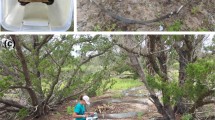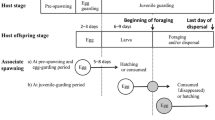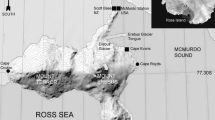Abstract
I investigated the nest association of pumpkinseeds and golden shiners in an upstate New York pond. Golden shiners spawned in about one-third of pumpkinseed nests. Field observations indicate that golden shiners preferred to spawn in nests of male pumpkinseeds that attracted conspecific females, and avoided nests of pumpkinseeds that failed to do so. Golden shiners did not spawn in any of the nests that I kept clean experimentally after abandonment by male pumpkinseeds, suggesting that a clean nest without a guarding pumpkinseed is not enough to attract shiners to spawn. In field experiments, shiner eggs that were placed away from pumpkinseed nests suffered significantly higher losses to predation than those in the nests. This indicates that golden shiners benefit from spawning in pumpkinseed nests through the protection of their young by the host pumpkinseed.
Similar content being viewed by others
References cited
Auer, N.A. (ed.). 1982. Identification of larval fishes of the Great Lakes Basin with emphasis on the Lake Michigan drainage. Great Lakes Fishery Commission Special Publication 82–3, Ann Arbor. 744 pp.
Baba, R., Y. Nagata & S. Yamagishi. 1990. Brood parasitism and egg robbing among three freshwater fish. Anim. Behav. 40: 776–778.
Buynak, G.L. & H.W. Mohr, Jr. 1980. Larval development of golden shiner and comely shiner from northeastern Pennsylvania. Prog. Fish-Cult. 42: 206–211.
Carr, M.H. 1946. Notes on the breeding habitats of the eastern stumpknocker, Lepomis punctatus punctatus (Cuvier). J. Florida Acad. Sci. 9: 101–106.
Côte, I.M. & W. Hunte. 1989. Male and female mate choice in the redlip blenny: why bigger is better. Anim. Behav. 38: 78–88.
DeMont, D.J. 1982. Use of Lepomis macrochirus Rafinesque nests by spawning Notemigonus crysoleucas (Mitchill) (Pisces: Centrarchidae and Cyprinidae). Brimleyana 8: 61–63.
Fletcher, D.E. 1993. Nest association of dusky shiners (Notropis cummingsae) and redbreast sunfish (Lepomis auritus), a potentially parasitic relationship. Copeia 1993: 159–167.
Goff, G.P. 1984. Brood care of longonose gar (Lepisosteus osseus) by smallmouth bass (Micropterus dolomieui). Copeia 1984: 149–152.
Hunter, J.R. & A.D. Hasler. 1965. Spawning association of the redfin shiner, Notropis umbratilis, and the green sunfish, Lepomis cyanellus. Copeia 1965: 265–281.
Hunter, J.R. & W.J. Wisby. 1961. Utilization of the nests of green sunfish (Lepomis cyanellus) by the redfin shiner (Notropis umbratilis) Copeia 1961: 113–115.
Johnston, C.E. 1994a. The benefit to some minnows of spawning in the nests of other species. Env. Biol. Fish. 40: 213–218.
Johnston, C.E. 1994b. Nest association in fishes: evidence for mutualism. Behav. Ecol. Sociobiol. 35: 379–383.
Johnston, C.E. & L.M. Page. 1992. The evolution of complex reproductive strategies in North American minnows (Cyprinidae). pp. 600–621. In: R.L. Mayden (ed.) Systematics, Historical Ecology, and North American Freshwater Fishes, Stanford University Press, Stanford.
Kramer, R.H. & L.L. Smith, Jr. 1960. Utilization of nests of large-mouth bass, Micropterus salmoides by golden shiners, Note-migonus crysoleucas. Copeia 1960: 73–74.
McKaye, K.R. 1981. Natural selection and the evolution of interspecific brood care in fishes, pp. 173–183. In: R.D. Alexander & D.W. Tinkle (ed.) Natural Selection and Social Behavior, Chiron Press, New York.
Morrison, J.R. & G.J. Burtle. 1989. Hatching of golden shiner eggs in hatchery tanks and subsequent fry survival in rearing ponds. Prog. Fish-Cult. 51: 229–231.
Pflieger, W.L. 1975. The fishes of Missouri. Missouri Department of Conservation, Jefferson City, 343 pp.
Rothstein, S.I. 1990. A model system of coevolution: avian brood parasitism. Annu. Rev. Ecol. Syst. 21: 481–508.
Serafy, J.E., R.M. Harrell & J.C. Stevenson. 1988. Quantitative sampling of small fishes in dense vegetation: design and field testing of portable ‘pop-nets’, J. Appl. Ichthyol. 4: 149–157.
Smith, C.L. 1985. The inland fishes of New York State. The New York State Department of Environmental Conservation, Albany. 522 pp.
Starnes, L.B. & W.C. Starnes. 1981. Biology of the blackside dace Phoxinus cumberlandensis. Amer. Midl. Nat. 106: 360–371.
Vives, S.P. 1990. Nesting ecology and behavior of hornyhead chub Nocomis biguttatus, a keystone species in Allequash creek, Wisconsin. Amer. Midl Nat. 124: 46–56.
Wallin, J.E. 1992. The symbiotic nest association of yellowfin shiners, Notropis lutipinnis, and bluehead chubs, Nocomis leptocephalus. Env. Biol. Fish. 33: 287–292.
Zar, J.H. 1984. Biostatistical analysis (2nd ed.). Prentice-Hall, Englewood Cliffs. 718 pp.
Zoran, M.J. & J.A. Ward. 1983. Parental egg care behavior and fanning activity for the orange chromide, Etroplus maculatus. Env. Biol. Fish. 8: 301–310.
Author information
Authors and Affiliations
Rights and permissions
About this article
Cite this article
Shao, B. Nest association of pumpkinseed, Lepomis gibbosus, and golden shiner, Notemigonus crysoleucas. Environmental Biology of Fishes 50, 41–48 (1997). https://doi.org/10.1023/A:1007360226057
Issue Date:
DOI: https://doi.org/10.1023/A:1007360226057




